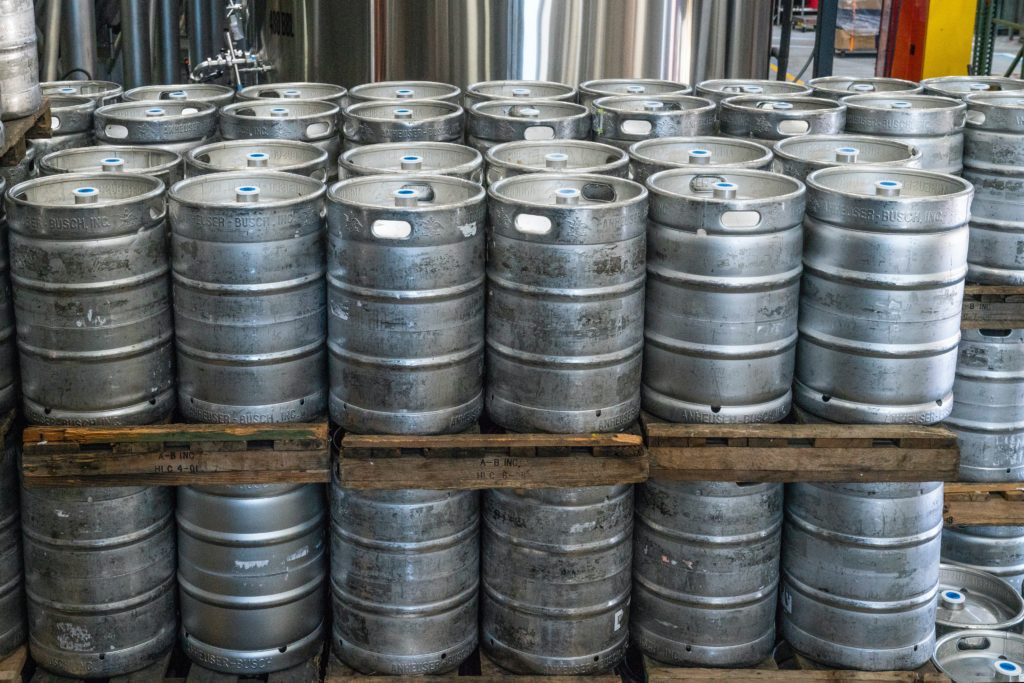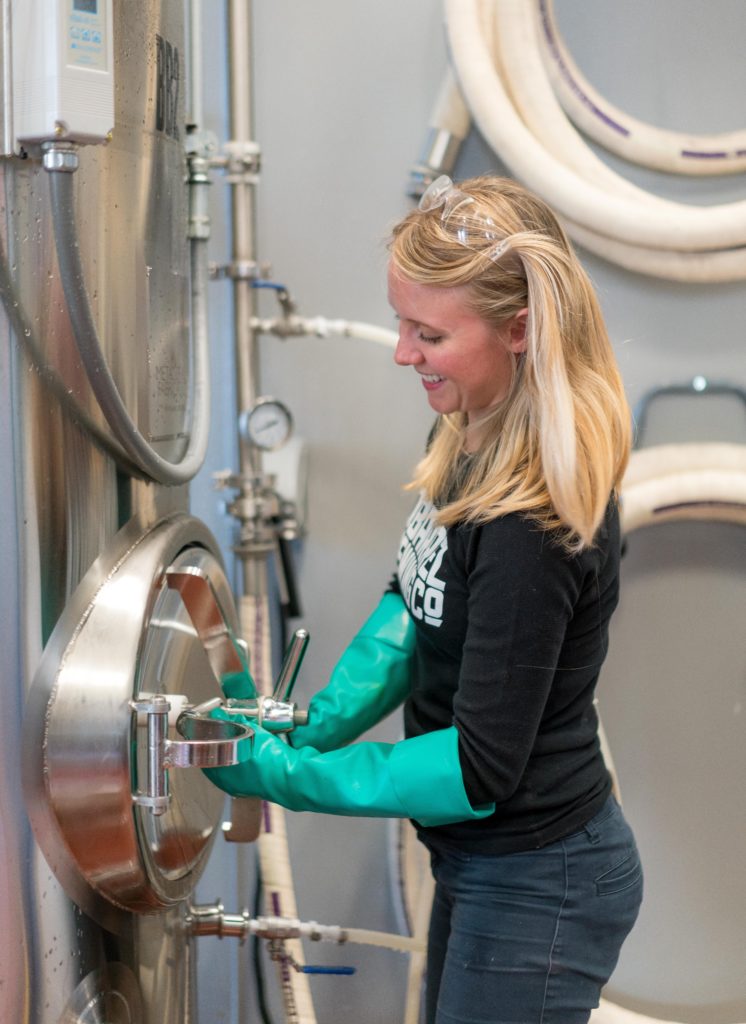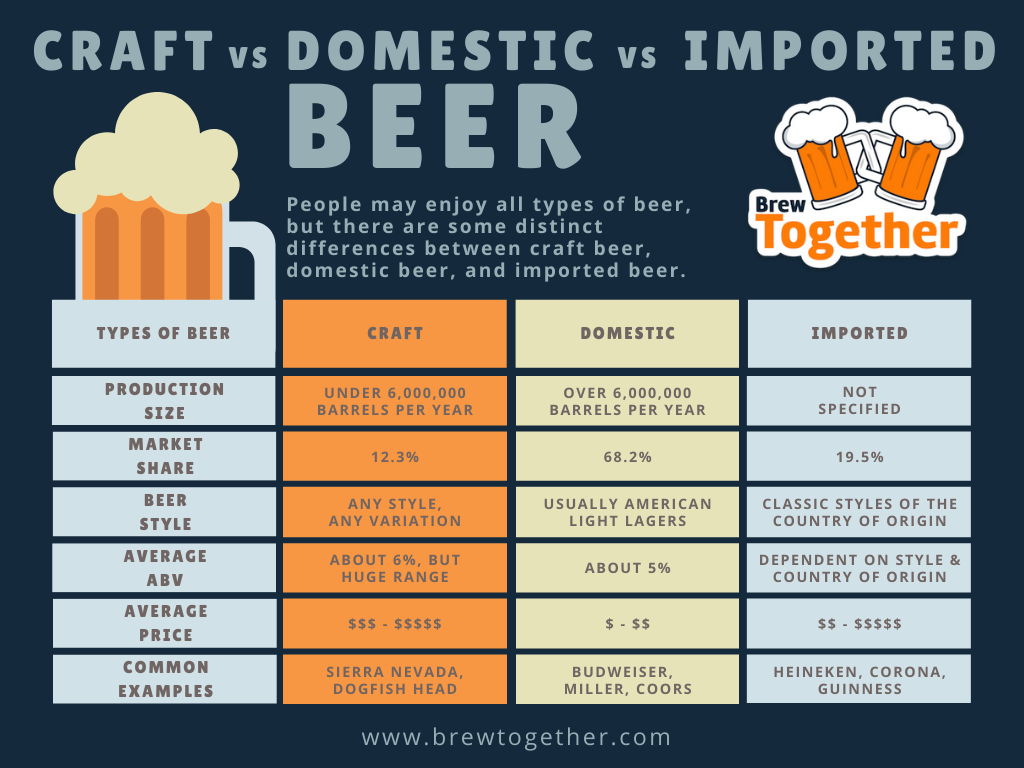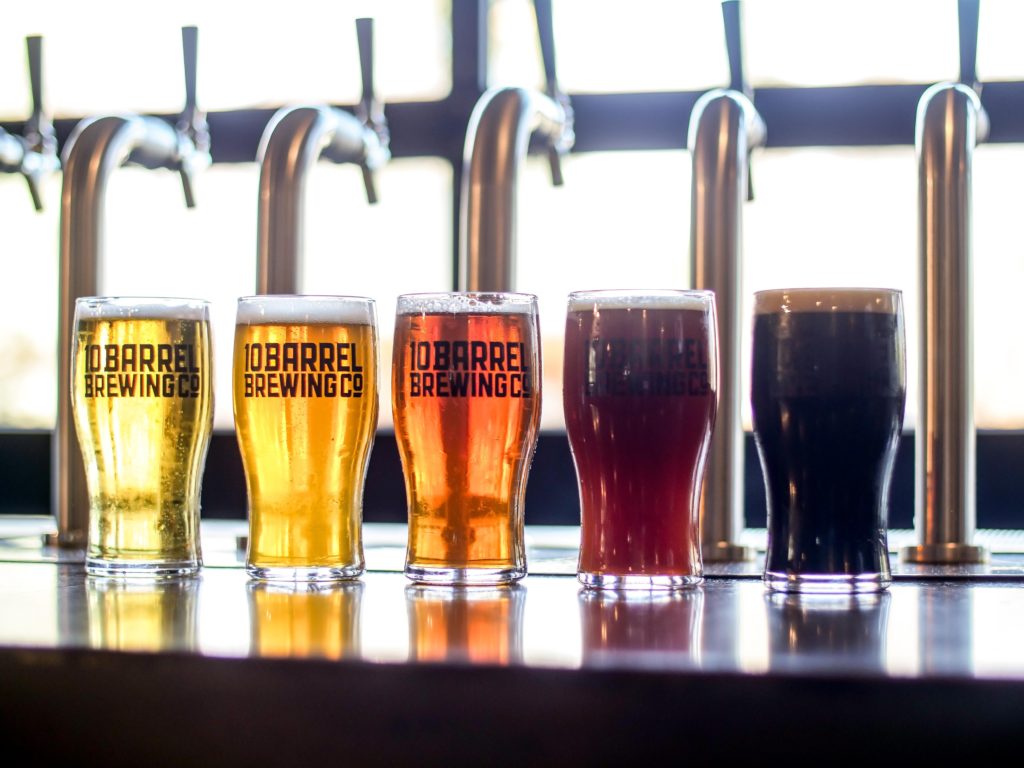Craft Beer vs Domestic Beer vs Imported Beer: What is the Difference Between These Beers?


Everyone knows someone who thinks that all beer is just beer. My grandfather and I, for example, agreed on many things. Beer was not one of them. He firmly believed that all beer was the same, and would just buy whatever the cheapest option was at the time. So at his house, you could expect to be served a Busch Light (or worse). One time, I brought an IPA to him and asked him to taste it, fully expecting to change his entire perspective on the world. He took a sip, made a sour face, and said “WHY THE HELL WOULD ANYONE DRINK THAT?” I thought to myself, “so that I don’t have to drink that awful yellow fizzy water you drink!”
Obviously, different people have different tastes, and there is a never-ending debate when it comes to beer. Some people (like me) are all about independently brewed craft beer. Others love their tried and true domestic beer. Others reject both options and instead opt to drink only imported beer. Very few of the people in these groups don’t care, and just about everyone seems to have a strong opinion on the matter based on their preferences.
As much as we here at BrewTogether are all about homebrewing and craft beer, we acknowledge that there are some great imports and, even though we hate to admit it, there are even some times when an old-school macrobrewery light lager isn’t the worst thing in the world. Even professional craft brewers drink the occasional domestic. Essentially what we’re saying is this: not all domestic beer is bad, and not all craft beer is good. With that said, there are many differences between craft, domestic, and imported beer that are worth understanding.
Just a quick note: this article is written from the perspective of a beer consumer in the United States. There is a growing craft beer movement across the globe (which we LOVE!), but the primary group of people we get this question from are located in the United States.
What is Craft Beer?
According to the Brewers Association, “craft beer” is beer that is brewed by small, independent, and traditional brewers. The term “craft” is used because it implies that these beers are crafted, rather than just manufactured, like those of a large-scale macrobrewery.
Craft beer breweries are small (more on that in a moment), and place a stronger emphasis on quality ingredients and traditional brewing techniques than large domestic breweries.
In the United States, a craft brewery must produce less than 6,000,000 barrels of beer per year. Before you ask, a barrel of beer in the United States is 31 US gallons. So, as long as a brewery produces less than 186,000,000 gallons of beer (which, if you’re interested, translates to 1,488,000,000 pints) per year, it can be considered “craft”. Obviously, this allows for some fairly large breweries to operate as craft breweries.


There are many larger craft beer brands available in the market today. Some of the most popular craft breweries are Sierra Nevada, New Belgium Brewing Company, Dogfish Head Brewery, Stone Brewing Co., and many others. These brands are known for their high quality and unique flavors. Keep in mind, though, that many American craft brewers are bought out and the breweries become owned by large beer manufacturers, like Anheuser-Busch InBev, the Miller Brewing Company, or the Molson Coors Brewing Company. While they are allegedly allowed to run independently, they are not truly independent breweries.
A smaller subset of craft breweries, called microbreweries, must brew less than 15,000 barrels of beer per year and must sell 75% or more of their beer offsite. If a microbrewery sells more than 25% of its beer onsite, it is considered a brewpub if it serves food or a taproom brewery if it does not serve food. These small, local breweries are likely what you think of when you think of craft beer. These small breweries are almost always locally owned and operated, and often where you can get the most diverse and interesting beer drinking experience.


The craft beer industry has exploded in the United States over the last 20 years. In 2002, there were about 1,500 breweries operating in the United States. In 2022, there are almost 9,000 breweries operating in the United States. While craft breweries can be found almost anywhere you go now, the west coast still dominates the market, and the majority of craft breweries are located in California, Colorado, Oregon, and Washington.
Craft beer encompasses virtually every style of beer imaginable. Generally, craft beers break with the American tradition of brewing only light lagers, and focus more on ales and more complex lager styles. Craft breweries are known for producing a higher number of India Pale Ales (IPAs), pale ales, stouts, sours, Belgian-style ales, and other diverse styles of beer that range greatly in ingredients, flavor, appearance, and alcohol content.
What is Domestic Beer?
In the United States, “domestic beer” is essentially just any large-scale brand of beer brewed by large American brewing companies. While the increasing popularity of craft beer has certainly expanded what people think of when they hear the word “beer”, domestic beer is still thought of as normal or regular beer that people most expect, because they are still the most popular beers on the market. Like any American company that has been around for a long time, these big breweries are heavily focused on scale and profit. These beers are typically mass-produced and have a wide distribution. Because of their need to appeal to a large group of people, domestic beers are almost always American light lagers. When you think of a domestic beer in the United States, you’re usually looking at a light American pale lager with about 4-5% alcohol by volume (ABV).
One convenient factor of domestic beers is that they are the easiest beer to find in the United States. Just about any grocery store or liquor store sells several options for domestic beer drinkers, ranging from very cheap to cheap in price. Domestic beer is readily available as draft beer in most restaurants and bars, as well as in cans and bottles. Domestic beer is even easy to purchase by the keg for at-home consumption. If you’re interested in purchasing beer by the keg, check out our Ultimate Guide to Kegs to learn more about sizes, prices, weights, and more! Basically, cheap beers are almost always domestic beers. If you’re at a bar with a light beer on a happy hour special, it’s almost certainly a domestic big-name beer.
In the United States, some of the most popular domestic beers include:
- Budweiser
- Bud Light
- Bud Light Lime
- Bud Ice
- Michelob Ultra
- Miller Genuine Draft
- Miller High Life
- Miller Lite
- Busch Light
- Coors Banquet
- Coors Light
- Pabst Blue Ribbon
- Natural Light
- Keystone Light
- Milwaukee’s Best Ice
What is Imported Beer?
Imported beer is any beer that is brewed in another country and then imported into the United States for sale to American beer drinkers. These beers can come from large international breweries or small, independent brewers, but most come from large brewing operations that would be considered “domestic beer” if they were made in the United States. With the increase of foreign craft beer entering the market, though, this percentage is starting to change.
Different types of beers are popular in different countries, and Americans enjoy many of them. Imported beer doesn’t have a single style, because import beers reflect the style of popular beer in the place where they are imported from.
For example, several foreign beer companies import their beer to the United States from Mexico, including Corona Extra, Modelo Especial, Sol, Dos Equis, and Pacifico. Because Mexican beer brands are so popular in the United States, they are imported in huge numbers and are available just about anywhere that sells beer. Other popular imported beer brands include Heineken (brewed in the Netherlands), Guinness (brewed in Dublin, Ireland), and Stella Artois (brewed in Belgium). Beer drinkers in the United States also consume a lot of German beer, as well as beer from the Czech Republic.
The Main Differences Between Craft Beer and Domestic Beer
People may enjoy all types of beers, but there are some distinct differences between craft beer, domestic beer, and imported beer.


Production Approach / Brewing Methods
One of the major differences between domestic beer and craft beer is the way it is made. Most domestic beers are brewed using mass production and large-scale manufacturing processes rather than traditional brewing practices. This is because domestic beer places a huge emphasis on consistency. They’re brewing billions and billions of pints of beer per year, and every single one has to taste exactly the same. Because of the large scale of production and emphasis on consistency, most domestic beers are produced largely through automated brewing processes using computer-controlled equipment.
Craft beers are typically brewed in smaller batches, and craft breweries usually make a much larger selection of beer styles at any given time. Because of this, there is generally a lower emphasis on consistency and more of an emphasis on quality and character for each beer. Craft breweries rely much more on the labor of professional brewers than automation. Because of this, there is usually a much richer experience in drinking craft beer.
Available Styles
Another major difference between craft and domestic beer is the number of styles of beer produced by each. Because they must appeal to the widest possible audience to be viable at the scale that domestic breweries produce them, domestic beers are generally limited to light lagers. These easy-drinking, cheap-to-make beers appeal to a large number of people. The business model clearly works, as domestic beer makes up 68.2% of the total beer sales in the United States. What this business model does not support, however, is flexibility, diversity, and adventurousness.
Because they brew in smaller batches and produce a more diverse portfolio of styles, craft beer brewers can afford to take more chances on a batch of beer that doesn’t sell well. Because of this, most craft breweries have a wide selection of different types of beer. Additionally, they will take chances on both brewing traditional styles that a domestic brewery wouldn’t dare brew as well as inventing completely new beer styles.


Drinking Experience:
The taste of craft beer is often more complex than domestic beer, even if the beer is a similar or even the same style. To reduce costs and increase profits, domestic beers are often brewed with adjunct grains added, including rice, which is not a common practice in craft brewing. Craft beers are brewed with high-quality, traditional ingredients and traditional brewing techniques, which results in a more flavorful beer. Domestic beer, on the other hand, is usually brewed to be cheap and palatable to the most people possible, which generally results in it being watery.
Does this mean that craft beer has a better taste? In our opinion, yes. But taste is subjective, and there are a lot of people who would disagree with us. Craft drinkers expect a much more complex experience from their beer, while domestic beer drinkers enjoy the crisp look, clean flavor profile, and lower calorie experience of domestic beer.
It is also worth noting that craft breweries often experiment with new and unique flavor combinations.The increased ability to experiment with ingredients and flavor profiles supports the idea that generally, craft beer tastes better than domestic beer.
The bitterness and hop aroma of craft beer is often higher than the bitterness of domestic beer. This is because craft breweries use more hops in the brewing process and focus on more hop-forward beers. The bitterness can also be affected by the type of hops used and how long they are boiled during the brewing process.
Availability:
Domestic beers are widely available in stores and restaurants, while specific craft beers can be more difficult to find. This is because craft breweries generally have smaller distribution areas than domestic breweries, and many craft beers are only available seasonally.
That doesn’t mean you won’t find craft beer readily available in general, though. In most grocery stores, bars, and restaurants across the United States, you’ll usually find at least a few, but usually several, craft beer options. Many grocery stores have even adopted the old bottle shop idea of a “build your own six-pack”, where you can choose individual bottles or cans of craft beer. So, while it may be a challenge to find the exact craft beer you’re looking for, there’s almost always a new one to try. If you want to try a whole bunch of craft beer from around the country, you might want to check out a craft beer subscription box service, like The Original Craft Beer Club or Beer Drop.
Price:
Craft beer is generally a bit more expensive than domestic beer. This is because craft breweries have a smaller production, which means that the cost of ingredients, labor, and overhead costs are higher per-pint. Just because craft beer costs a bit more doesn’t mean it’s not worth it. Most beer lovers agree that craft beer is much better than domestic beer and worth the premium price.
The majority of craft breweries are small, independent businesses. These companies often employ local people and support the local economy. In contrast, domestic breweries are typically owned by large, international corporations. If you want to play an active part in trying to strengthen the economy of your city or state, then it is important to support small and independent local businesses in your locality instead of only buying from larger corporations.
We’ve been asked, “how can you justify spending that much money on a beer?” Consider this, when you support any small business, including a craft brewery, try to remember that the extra money you’re paying isn’t just for the end product itself. It is to pay for the very existence of the option. So, while it is easy to say a pint of beer isn’t worth $8, the real question is, “is the option to purchase craft beer, with all of its unique styles, worth $8?”, because if we stop buying it, these breweries will all go out of business, and we will be back to drinking only domestic beer.
Alcohol Content
On average, craft beers typically have a higher alcohol content than domestic beers. This is generally because domestic beers are brewed to be light, relatively low in calories, and able to be consumed in larger quantities. Craft breweries tend to brew styles of beer that have higher standard alcohol percentages than those typical of a light lager.
Keep in mind, there is a huge range in alcohol content in craft beer, and you should always make sure you know the amount of alcohol in a beverage before consuming it. For those used to drinking domestic beer, which is usually between 4% and 5% alcohol by volume (ABV), be cautious when drinking craft beer. It’s very common for craft beers to range in the 6% – 7% range, making it substantially stronger than a domestic beer.
Imported Beer Characteristics
The characteristics of imported beer depend on the country of origin. The flavor, brewing method, quality, and other characteristics may all depend on the country the beer is brewed in. So the characteristics of the imported beer as a group cannot have a generalized comparison with the craft and domestic beer.
The taste of imported beer is often perceived to be more complex than domestic beer. The flavor of imported beer reflects the preferences and brewing traditions from the country it is brewed in. This means that the flavor of each imported beer will be different and unique, depending on the country it is from.
For example, Mexican Cerveza-style beers are light and refreshing, because they are intended to be consumed in a warm climate. Russian stouts, however, are dark and high in alcohol content, which provides a warming effect. Different still, the various Belgian styles of beer, all with very unique qualities completely different from those produced by domestic breweries in the United States, follow a long tradition of beer brewing that is closely aligned to Belgian history and culture.
The food and drink from any country is a big reflection of its culture. In order to fully experience the cultural essence of any region, it is important to get a taste of the food and beverages from that country.
Imported Beers Aren’t As Expensive As You Might Think
Imported beer ranges from inexpensive (nearly as cheap as an average domestic) to very expensive. Some imported beers can be more expensive than both domestic and craft beers.
While some imported beers may be a bit more expensive than domestic beers, they usually aren’t as expensive as you might think. This is because the price of imported beer usually depends on the country of origin, import laws, and the brand itself. So different factors play a huge role in determining the price of imported beer.
The Verdict
So, what’s the verdict? Which type of beer is the best? It really depends on your personal preferences and the kind of beer that you like. Craft, domestic, and international breweries all produce some good beers and there are avid beer drinkers that prefer each type. If you’re looking for a complex and flavorful beer, then craft brews are the way to go. However, if you’re looking for a cheap and widely available beer, then domestic beer is a good option. If you’re looking for a classic and iconic beer, then imported beer may be the way to go.
Ultimately, it’s up to you to decide which type of beer is the best for you. The best part? You can have all three! Head out to your favorite bar’s happy hour and try a beer you haven’t before. You just might like it! Cheers!
Thanks for Reading!
Did we miss your favorite craft, domestic, or imported beer? Let us know in the comments and we’ll add it to the article! Do you still have questions about craft beer vs domestic beer vs imported beer, or anything else beer and brewing related? Leave a comment below or post in the forums! The BrewTogether Community is made up of an awesome group of homebrewers around the world that are always supportive and happy to help answer your questions!
Thank you for reading! If you like this article, please share it with your friends using the social media share buttons below! We need your help getting the word out about BrewTogether!
If you’re not a member of BrewTogether, we’d love for you to join! BrewTogether is completely free, and signing up is easy! Click here to join! We’d love to have you as a member of the BrewTogether Community!
Now using BrewTogether is easier than ever! Download the FREE BrewTogether Mobile App – available on both the Apple App Store and the Google Play Store! The BrewTogether App is completely free and drastically improves the experience of using BrewTogether on a mobile device.






Responses